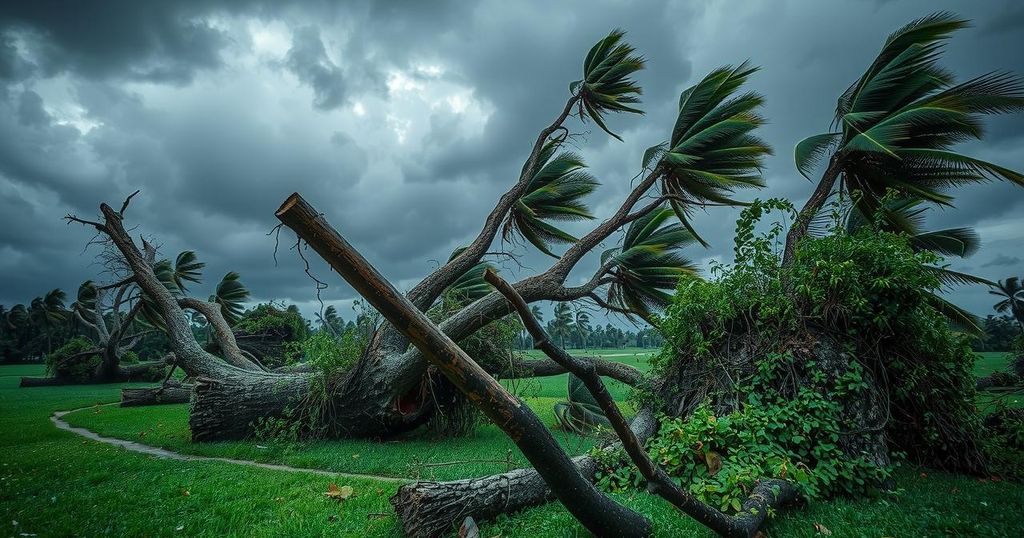Cyclone Jude Causes Devastation in East Africa: 17 Lives Lost and Thousands Affected
Cyclone Jude has resulted in 17 fatalities in East Africa, with significant destruction reported in Mozambique and Madagascar. Over 130 injuries have been recorded, and thousands have been displaced. The cyclone caused extensive property damage, particularly in education and health infrastructure, impacting hundreds of thousands across the region.
Cyclone Jude has caused significant devastation in East Africa, resulting in 17 fatalities, with 16 individuals dead in Mozambique and one in Madagascar, according to the European Civil Protection and Humanitarian Aid Operations (ECHO). Over 130 people have sustained injuries, and four individuals are reported missing as of March 18. The cyclone has affected approximately 400,000 people across Madagascar, Mozambique, and Malawi, displacing over 10,500 people in Madagascar and nearly 5,000 in Malawi.
The cyclone made its initial landfall in northern Madagascar on March 8, prompting many residents to seek refuge in temporary shelters. Following its trajectory westward, the storm strengthened over the Mozambique Channel and made landfall in Mozambique’s Mossuril district on March 10, exhibiting maximum sustained winds of 140 kph (87 mph) and gusts reaching 195 kph (121 mph). An extraordinary amount of rainfall, surpassing 250 millimeters (9.8 inches) within 24 hours, was recorded, leading to severe flooding in coastal districts.
In Mozambique, the cyclone resulted in the cancellation and delay of numerous flights and the destruction of approximately 900 houses. Flooding affected 49,593 hectares (122,547 acres) of cropland in Monapo, Nampula, and a cholera outbreak was reported in Larde. Meanwhile, over 400,000 residents in Nampula experienced power outages. A UNICEF spokesperson noted that full river basins and dams exacerbated the flooding situation, emphasizing the scale of the disaster.
Ahead of the storm, the U.N. Central Emergency Response Fund expedited a release of $6 million to facilitate early warnings and provide shelter, hygiene, and water treatment supplies, as reported by ECHO. Cyclone Jude also impacted Malawi from March 10 to 12, bringing heavy rains before reverting back to Mozambique.
ECHO documented extensive destruction in Mozambique, with 70,000 homes, 247 schools, 72 health facilities, 48 water systems, and 18 bridges significantly damaged or destroyed by March 18. Cyclone Jude became the third cyclone to afflict Mozambique within a three-month period, following Cyclone Chido in December and Cyclone Dikeledi in January.
After returning to Madagascar on March 15, the cyclone affected educational institutions severely, with 89 classrooms destroyed and 182 partially damaged. Approximately 48,000 students were unable to attend school as a result. ECHO highlighted that this catastrophic weather system has uniquely crossed the southern region of Madagascar, inundating over a thousand houses, damaging around 1,600, and destroying 1,160 homes. Many areas, including the districts of Ampanihy, Bekily, Beloha, and Tsihombe, remain isolated, obstructing humanitarian aid efforts.
In conclusion, Cyclone Jude has inflicted dire consequences in East Africa, claiming lives and causing significant property damage across Mozambique and Madagascar. With over 400,000 individuals affected and vital infrastructure severely impaired, the situation remains critical. Efforts to provide relief and restore normalcy in the disaster-stricken regions are ongoing, yet challenges persist due to accessibility issues. The cyclone serves as a grim reminder of the region’s vulnerability to severe weather events.
Original Source: news.mongabay.com




Post Comment